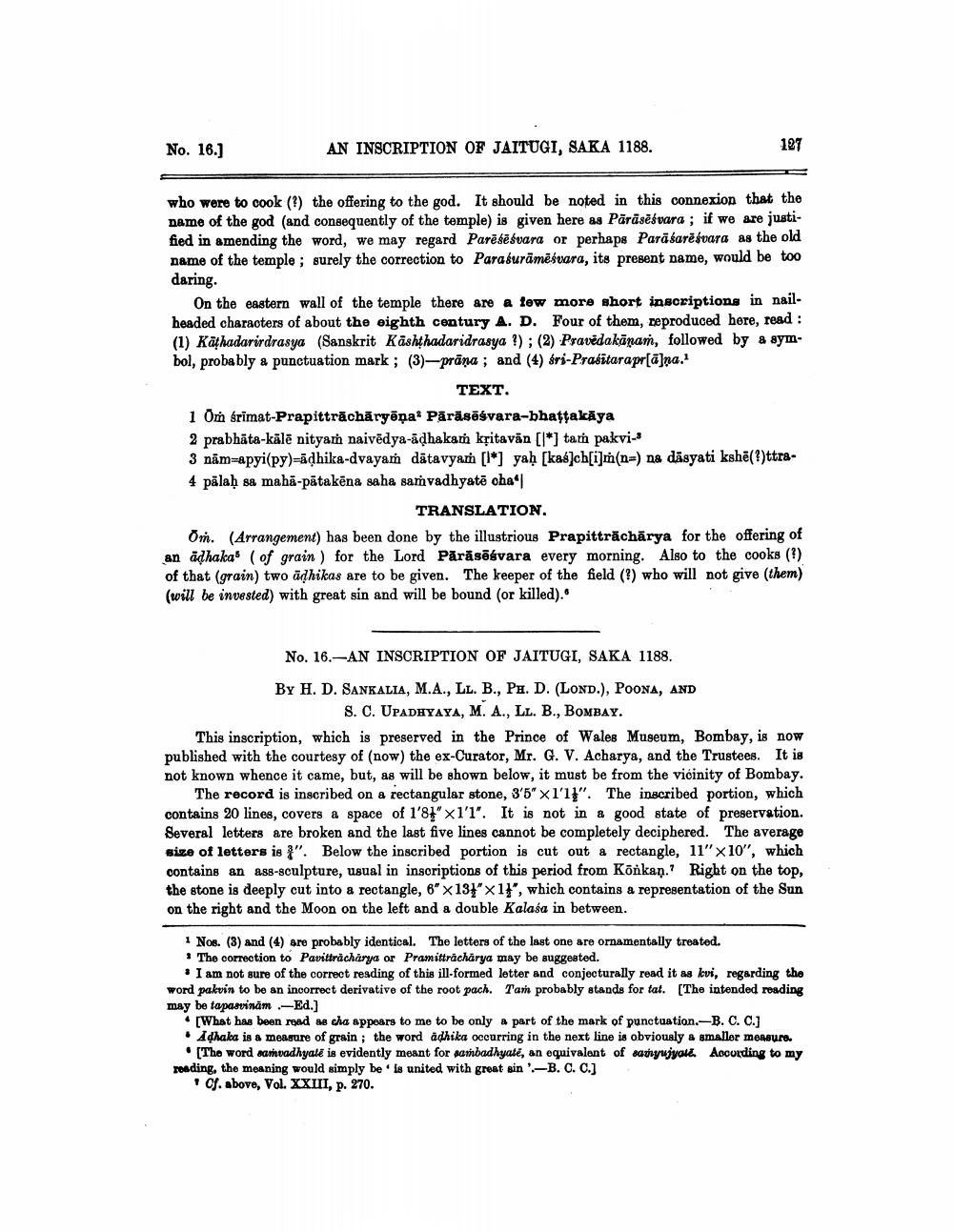________________
No. 16.)
AN INSCRIPTION OF JAITUGI, SAKA 1188.
127
who were to cook (?) the offering to the god. It should be noted in this connexion that the name of the god (and consequently of the temple) is given here as Pārāsësvara; if we are justified in amending the word, we may regard Parēsēśvara or perhaps Parāśarësvara as the old name of the temple ; surely the correction to Paraburāmēsvara, its present name, would be too daring.
On the eastern wall of the temple there are a few more short inscriptions in nailheaded characters of about the eighth century A. D. Four of them, reproduced here, read : (1) Käthadarirdrasya (Sanskrit Käshthadaridrasya ?) ; (2) Pravedakānam, followed by a symbol, probably a punctuation mark; (3)-prāna ; and (4) Sri-Prasītarapr[a]na1
TEXT. 1 Om Srimat-Prapittrāchāryāņa Pārāsāśvara-bhattakāya 2 prabhāta-kālē nityam naivēdya-ādhakam kritavān [l*] tam pakvi3 nāmapyi(py)=ādhika-dvayam dātavyari [1*] yah (kab]ch[i]ņ(n=) na dasyati kshë(?)ttra4 pälah sa mahā-pātakēna saha samvadhyatē cha |
TRANSLATION. on. (Arrangement) has been done by the illustrious Prapitträchärya for the offering of an adhakas (of grain ) for the Lord Pārāsāśvara every morning. Also to the cooks (?) of that (grain) two ādhikas are to be given. The keeper of the field (?) who will not give them) (will be invested) with great sin and will be bound (or killed).
No. 16.-AN INSCRIPTION OF JAITUGI, SAKA 1188.
BY H. D. SANKALIA, M.A., LL. B., Ph. D. (LOND.), POONA, AND
S. C. UPADHYAYA, M. A., LL. B., BOMBAY. This inscription, which is preserved in the Prince of Wales Museum, Bombay, is now published with the courtesy of (now) the ex-Curator, Mr. G. V. Acharya, and the Trustees. It is not known whence it came, but, as will be shown below, it must be from the vioinity of Bombay.
The record is inscribed on a rectangular stone, 3'5" X 1'11". The inscribed portion, which contains 20 lines, covers a space of 1'8}" x 1'1". It is not in a good state of preservation. Several letters are broken and the last five lines cannot be completely deciphered. The average size of letters is ". Below the inscribed portion is cut out a rectangle, 11" x 10", which contains an ass-sculpture, usual in inscriptions of this period from Konkan.' Right on the top, the stone is deeply cut into a rectangle, 6"x13" x 11", which contains a representation of the Sun on the right and the Moon on the left and a double Kalasa in between.
1 Nos. (3) and (4) are probably identical. The letters of the last one are ornamentally treated. • The correction to Pavittracharya or Pramittracharya may be suggested.
* I am not sure of the correct reading of this ill-formed letter and conjecturally read it as kvi, regarding the word pakvin to be an incorrect derivative of the root pach. Tan probably stands for tat. (The intended reading may be tapasvinam .-Ed.) • [What has been read as cha appears to me to be only a part of the mark of punctuation.-B. C. C.]
Adhaka is a measure of grain; the word adhika occurring in the next line is obviously a smaller monsure.
[The word samvadhyatē is evidently meant for samoadhyate, an equivalent of satyujyate. According to my reading, the meaning would simply be is united with great sin '.-B. C. C.)
Of. above, Vol. XXIII, p. 270.




